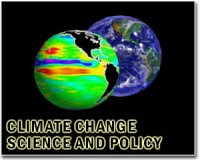| . |  |
. |
Buffalo NY (SPX) Oct 29, 2009 The possibility that climate change might simply be a natural variation like others that have occurred throughout geologic time is dimming, according to evidence in a Proceedings of the National Academy of Sciences paper. The research reveals that sediments retrieved by University at Buffalo geologists from a remote Arctic lake are unlike those seen during previous warming episodes. The UB researchers and their international colleagues were able to pinpoint that dramatic changes began occurring in unprecedented ways after the midpoint of the twentieth century. "The sediments from the mid-20th century were not all that different from previous warming intervals," said Jason P. Briner, PhD, assistant professor of geology in the UB College of Arts and Sciences. "But after that things really changed. And the change is unprecedented." The sediments are considered unique because they contain rare paleoclimate information about the past 200,000 years, providing a far longer record than most other sediments in the glaciated portion of the Arctic, which only reveals clues to the past 10,000 years. "Since much of the Arctic was covered by big ice sheets during the Ice Age, with the most recent glaciations ending around 10,000 years ago, the lake sediment cores people get there only cover the past 10,000 years," said Briner. "What is unique about these sediment cores is that even though glaciers covered this lake, for various reasons they did not erode it," said Briner, who discovered the lake in the Canadian Arctic while working on his doctoral dissertation. "The result is that we have a really long sequence or archive of sediment that has survived arctic glaciations, and the data it contains is exceptional." Working with Briner and colleagues at UB who retrieved and analyzed the sediments, the paper's co-authors at the University of Colorado and Queens University, experts in analyzing fossils of bugs and algae, have pooled their expertise to develop the most comprehensive picture to date of how warming variations throughout the past 200,000 years have altered the lake's ecology. "There are periods of time reflected in this sediment core that demonstrate that the climate was as warm as today," said Briner, "but that was due to natural causes, having to do with well-understood patterns of the Earth's orbit around the sun. The whole ecosystem has now shifted and the ecosystem we see during just the last few decades is different from those seen during any of the past warm intervals." Yarrow Axford, a research associate at the University of Colorado, and the paper's lead author, noted: "The 20th century is the only period during the past 200 millennia in which aquatic indicators reflect increased warming, despite the declining effect of slow changes in the tilt of the Earth's axis which, under natural conditions, would lead to climatic cooling." Co-authors with Briner and Axford are Colin A. Cooke and Alexander P. Wolfe of the University of Alberta; Donna R. Francis of the University of Massachusetts; John P. Smol, Cheryl R. Wilson and Neal Michelutti at Queens University; Gifford H. Miller of the University of Colorado and Elizabeth K. Thomas, who did this work at UB for her master's degree in geology. The University at Buffalo is a premier research-intensive public university, a flagship institution in the State University of New York system and its largest and most comprehensive campus. UB's more than 28,000 students pursue their academic interests through more than 300 undergraduate, graduate and professional degree programs. Founded in 1846, the University at Buffalo is a member of the Association of American Universities. Share This Article With Planet Earth
Related Links University at Buffalo Climate Science News - Modeling, Mitigation Adaptation
 EU urged to raise bar on climate financing
EU urged to raise bar on climate financingBrussels (AFP) Oct 28, 2009 European Union leaders were on Wednesday told they have to find 15 billion euros a year to help developing countries fight global warming if this week's summit is to be deemed successful. Leaders from the EU's 27 member countries are split into three camps going into a summit starting Thursday at which they will try to agree a common line to take into United Nations negotiations in ... read more |
|
| The content herein, unless otherwise known to be public domain, are Copyright 1995-2009 - SpaceDaily. AFP and UPI Wire Stories are copyright Agence France-Presse and United Press International. ESA Portal Reports are copyright European Space Agency. All NASA sourced material is public domain. Additional copyrights may apply in whole or part to other bona fide parties. Advertising does not imply endorsement,agreement or approval of any opinions, statements or information provided by SpaceDaily on any Web page published or hosted by SpaceDaily. Privacy Statement |